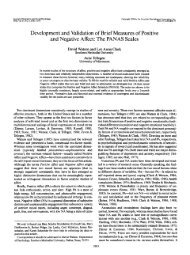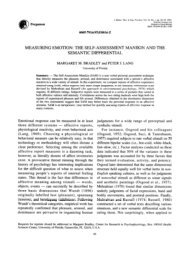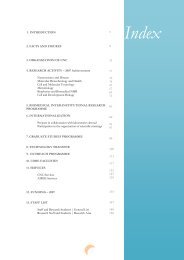Annual Report of Activities CNC 2008 - Center for Neuroscience and ...
Annual Report of Activities CNC 2008 - Center for Neuroscience and ...
Annual Report of Activities CNC 2008 - Center for Neuroscience and ...
Create successful ePaper yourself
Turn your PDF publications into a flip-book with our unique Google optimized e-Paper software.
Mitochondrial Toxicology <strong>and</strong> Pharmacology | Head: Paulo OliveiraObjectivesMitochondria are the energy powerplants <strong>of</strong> cellsby producing the majority <strong>of</strong> the chemical energycell use <strong>for</strong> their processes. The majorbreakthrough happened with the discovery thatmitochondria play an important role in cell deathprocesses. Together with the fact that mitochondriaalso are active players in cytosolic calciumhomeostasis <strong>and</strong> in intermediate metabolism, it ispertinent to question if different molecules, whichcan interact with living systems, or even diseaseconditions, promote their biological effects throughmitochondrial‐mediated effects. In fact, numerousexamples <strong>of</strong> mitochondria‐mediated cell injury canbe found in the literature; not only chemicals cannegatively affect mitocondrial function but also theorigin <strong>and</strong> progression <strong>of</strong> several pathologies isclosely related with disruption <strong>of</strong> mitochondrialhomeostasis. The main <strong>and</strong> general objective <strong>of</strong> the“Mitochondrial Toxicology <strong>and</strong> PharmacologyGroup” is to provide an insight into the role <strong>of</strong>mitochondria as a primary intracellular target inthe initiation <strong>of</strong> drug‐ <strong>and</strong> disease‐induced celldysfunction. The main particular objective is tounderst<strong>and</strong> how mitochondria are involved in thepathophysiology <strong>of</strong> several diseases, includingdiabetes <strong>and</strong> cholestasis <strong>and</strong> how mitochondrialfunction can be altered by chemotherapy, not onlyto decrease the side effects <strong>of</strong> agents commonlyused in oncology, but also to specifically identifynew mitochondrial targets in tumor cells. We usedifferent in vitro (isolated mitochondrial fractions,cultured cell lines) <strong>and</strong> in vivo models (animalmodels <strong>of</strong> stress or disease‐induced mitochondrialalterations) in order to gather in<strong>for</strong>mation on howmitochondria are affected by xenobiotics orstressful situations (e.g. exercise, differentpathologies) <strong>and</strong> the relevance <strong>for</strong> the tissuehomeostasis.Main AchievementsOur research group has provided several seminalworks in different lines <strong>of</strong> research, in which thefollowing:1) Mitochondrial toxicity <strong>of</strong> anticancer agents: Wehave investigated the role <strong>of</strong> mitochondria, notonly as a plausible target <strong>of</strong> novelchemotherapeutics in cancer cells, but also as amediator <strong>of</strong> toxicity <strong>of</strong> clinically used antineoplasticagents. We have demonstrated that twoplant alkaloids, berberine <strong>and</strong> sanguinarine,present a selective cytotoxic effect on human <strong>and</strong>mouse metastatic melanoma cells by targetingmitochondria, which can be a breakthrough in thetreatment <strong>of</strong> advanced melanoma. We haveidentified the adenine nucleotide translocator as acritical target <strong>of</strong> berberine. We also concluded thatthe activation <strong>of</strong> the p53‐Bax axis occurs upstream<strong>of</strong> mitochondrial dysfunction induced by thecardiotoxicant doxorubicin in H9c2 myoblasts.2) Mitochondrial alterations during hepaticdiseases: Non‐alcoholic fatty liver disease(NAFLD) is an increasingly reported pathology,characterized by fat accumulation within thehepatocyte. We have demonstrated that cholinedeficientanimals have disturbed mitochondrialcalcium accumulation <strong>and</strong> bioenergetics, as well asincreased oxidative stress, which suggests amechanism <strong>for</strong> the development <strong>of</strong> NALFDassociated with altered mitochondrial function.3) Xenobiotic‐induced mitochondrial alterations:We have screened the toxicity <strong>of</strong> severalcompounds with clinical relevance in both heart<strong>and</strong> liver mitochondrial fractions. Of specialrelevance, we tested Indirubin‐3ʹ‐oxime, whichimpairs mitochondrial oxidative phosphorylation<strong>and</strong> prevents mitochondrial permeability transitioninduction, the insecticide methoprene, whichshowed a lower toxicity when compared withother compounds <strong>of</strong> the same family,mildronate, which was shown to prevent AZTinducedmitochondrial toxicity <strong>and</strong> Sildenafilcitrate, which was shown to decreasemitochondrial oxidative stress atconcentrations that did not affectmitochondrial bioenergetics.49






